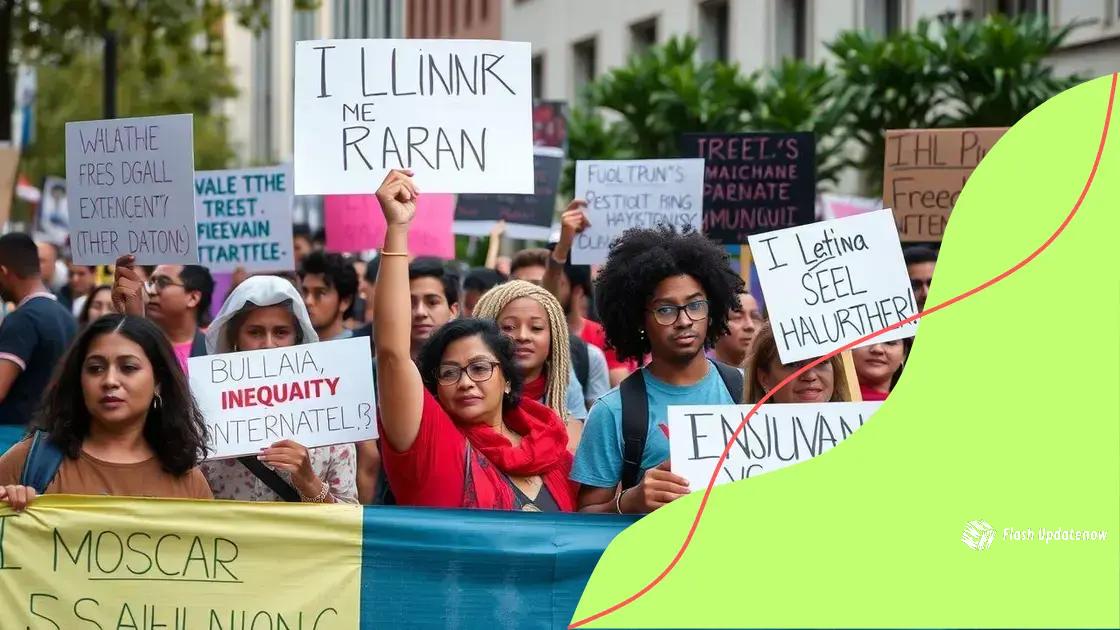National protest movements: understanding their impact

National protest movements are collective actions that aim to address social, political, and economic issues, raising awareness and influencing public policy for change.
National protest movements have become a vital expression of societal issues and aspirations. Have you ever wondered how these movements shape our communities and policies? Let’s dive into their significance.
Defining national protest movements
Understanding national protest movements is essential to grasp their role in society. These movements represent collective action where groups seek political or social change. They often arise in response to perceived injustices, inequalities, or governmental failures.
To define what a national protest movement is, we can look at key characteristics. These movements:
Characteristics of National Protest Movements
- Involve large groups of people advocating for a common cause.
- Occur within a specific country, reflecting local issues.
- Utilize various forms of protest, such as marches, sit-ins, and online campaigns.
- Often aim to influence public opinion or bring attention to specific issues.
Historically, national protest movements have shaped policies and brought about significant societal changes. Iconic examples include the Civil Rights Movement in the United States and the anti-apartheid movement in South Africa. These movements not only stirred local audiences but also garnered international attention, showcasing the power of collective action.
Moreover, social media has transformed the landscape of national protest movements. Today, platforms like Twitter and Facebook enable rapid organization and dissemination of information. This has led to a more interconnected global approach in activism. Movements can now gain support from diverse international communities, expanding their impact.
Ultimately, recognizing the characteristics and historical significance of national protest movements helps us appreciate their ongoing relevance in society. From local gatherings to worldwide campaigns, these movements reflect our collective desire for change and justice.
Historical context of protests
The historical context of protests reveals how movements have evolved over time. Social movements often arise in response to injustices, whether political, economic, or social. Throughout history, many protests have shaped nations and influenced the course of events.
Understanding key moments in protest history helps to appreciate their significance today. Major protests such as the Boston Tea Party and the Women’s Suffrage Movement were not just isolated events but pivotal moments that sparked broader movements. They demonstrated how collective action could address pressing issues and push for change.
Key Historical Protests
- The American Civil Rights Movement fought against racial segregation and discrimination.
- The anti-war protests during the Vietnam War highlighted public dissent and the power of civil disobedience.
- The Stonewall Riots marked a turning point for LGBTQ+ rights and visibility.
- Global movements, like the Arab Spring, showcased the impact of social media in organizing protests.
Protests have also played a crucial role in shaping legislation and influencing public opinion. For instance, the Civil Rights Act of 1964 was a direct outcome of sustained activism. This shows how protests can catalyze social change.
Moreover, historical context adds depth to our understanding of current protests. Many movements today draw inspiration from past struggles, highlighting a continuity in the fight for justice. Activists often look to historical precedents to learn from successes and failures, making history an essential tool for modern-day advocacy.
By examining the roots and impacts of historic protests, we can better understand the motivations behind current struggles. Each decade has seen its share of unrest, reflecting the ongoing fight for rights and recognition.
Key factors driving protest movements

Understanding the key factors driving protest movements is essential in recognizing why people come together to advocate for change. Various social, political, and economic conditions often inspire individuals to mobilize and express their grievances.
One primary factor is inequality. When groups feel marginalized or disadvantaged, they may resort to protest as a means of demand for equal rights and social justice. This was evident during the Occupy Wall Street movement, which highlighted the wealth gap in society.
Additional Driving Factors
- Political repression: When governments stifle free speech and assembly, it often ignites protests.
- Economic crises: High unemployment and inflation can prompt people to take to the streets in search of change.
- Social media: The rise of online platforms allows for rapid organization and awareness, making it easier for movements to gain momentum.
- Cultural shifts: Changing societal norms can inspire protests, as seen in movements advocating for LGBTQ+ rights.
Moreover, historical context greatly influences the current events. Each cultural and societal backdrop creates a unique environment for protest. For instance, a country with a history of authoritarian rule may have different motivators compared to a democratic nation facing economic hardships.
As people unite for a common cause, these driving factors intertwine, making each protest distinct. The emotional charge behind these issues often fuels passion and determination, propelling movements forward.
Thus, recognizing these factors sheds light on the complexities surrounding protests. Every movement arises from a blend of conditions and grievances, reflecting the struggles of those involved. Understanding them is key to grasping the broader social dynamics at play.
Impacts of national protests on society
The impacts of national protests on society are significant and varied. When people take to the streets, they often bring attention to critical issues that need addressing. Protests can lead to changes in laws, policies, and public attitudes.
One of the primary impacts is the raising of awareness about social injustices. Through protests, marginalized voices can be amplified, making society more aware of their struggles. This exposure can lead to a greater understanding and empathy within the broader population.
Key Impacts of Protests
- Policy Changes: Protests can result in new laws or modifications to existing legislation, reflecting the demands of the people.
- Public Discourse: They stimulate conversations around important issues, often pushing these topics into mainstream media.
- Community Solidarity: Protests build community among participants, fostering a sense of unity and shared purpose.
- Global Influence: Movements can inspire others worldwide, leading to similar protests in various countries.
Moreover, the impacts of protests can sometimes be divisive. While they unite certain groups, they can also lead to backlash from opposing factions. For example, protests advocating for racial justice may meet resistance from those who feel threatened by the call for equality.
The long-term effects can also depend on how society reacts to these movements. Consistent activism can strengthen civil society, encouraging citizens to demand change regularly. Conversely, if protests are met with repression, it may lead to increased tension and conflict within communities.
In some cases, sustained protests can result in political change, as evidenced in various countries where governments have had to respond to public outcry. This illustrates the power of collective action in shaping societal norms and practices.
Future of protest movements
The future of protest movements is poised to evolve with changing social dynamics and technological advancements. As society faces new challenges, the methods and motivations behind protests are likely to shift.
Digital platforms such as social media will continue to play a vital role in organizing and promoting protests. Online activism allows for swift mobilization, enabling individuals to connect across vast distances. This connectivity can amplify voices and broaden the reach of movements, allowing for quicker responses to injustices.
Trends Shaping Future Protests
- Increased use of technology: Innovations such as apps for coordination and secure communication may enhance organization.
- Focus on global issues: Climate change and inequality are likely to drive more international solidarity movements.
- Intersectionality: Future protests may become more inclusive, addressing multiple issues and supporting various marginalized groups.
- Legal challenges: As protests become more frequent, governments may implement stricter regulations, leading to potential clashes between authorities and activists.
The ways people engage with protests are also changing. Younger generations prioritize sustainability and social justice, which may influence the platforms and messages used in future movements. This shift could redefine what activism looks like, blending traditional methods with innovative approaches.
Furthermore, the response to protests will likely shape the trajectory of future movements. Successful interventions may encourage more people to join; however, excessive repression can stifle dissent and prompt more underground organizing.
Overall, as the world continues to change, so too will the landscape of protest movements. The need for social justice and political representation will remain a priority, driving individuals to unite for causes that matter deeply to them.
FAQ – Frequently Asked Questions about National Protest Movements
What role do national protest movements play in society?
National protest movements raise awareness about social issues, influence public policy, and unite communities for common causes.
How can technology impact future protests?
Technology, especially social media, allows for rapid organization and broad outreach, enabling movements to gain momentum quickly.
What factors drive people to participate in protests?
Key factors include inequality, political repression, economic crises, and the desire for social change.
Can protests lead to lasting change?
Yes, protests can result in significant policy changes and increased public awareness, contributing to long-term societal shifts.
